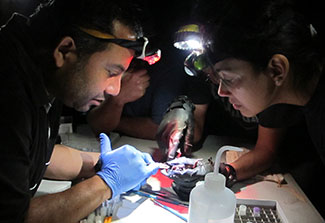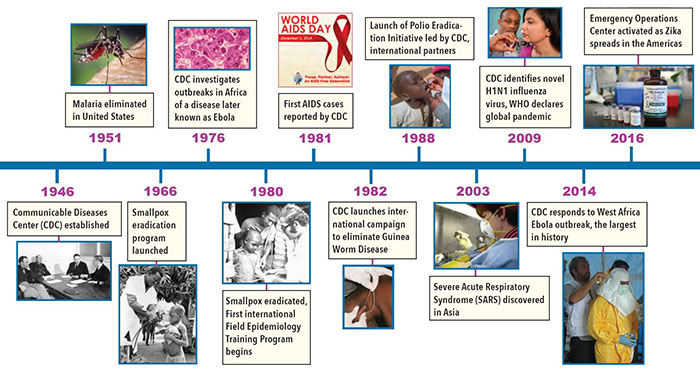
CDC celebrates 70 years of global health leadership
September / October 2016 | Volume 15, Number 5

Photo courtesy of CDC
The CDC is marking 70 years of accomplishments in global
health, including training thousands of scientists worldwide
to help identify and control disease outbreaks.
health, including training thousands of scientists worldwide
to help identify and control disease outbreaks.
By Karin Zeitvogel
In 70 years of existence, the Centers for Disease Control and Prevention (CDC) has grown from an agency focused on eliminating malaria in the United States to a global health leader that uses research and rapid interventions to improve lives and respond to health emergencies in a shrinking world.
Since it was founded in 1946, the CDC - which at the time stood for the Communicable Diseases Center - has become “the gold standard for the world” in terms of global health, Dr. William L. Foege said at a recent anniversary event at CDC's headquarters in Atlanta, Ga. Foege and six other CDC directors, who led the agency from the late 1970s until today, gathered with staff to celebrate seven decades of public health milestones.
“The Ebola outbreak, and now the Zika outbreak, continue to show that the CDC effort is needed in order to provide for a healthy world,” said Foege, who headed the agency from 1977-1983 and is widely credited with devising the successful strategy that eradicated smallpox, which he then took to the Carter Center to try to end Guinea worm disease.
After achieving its initial goal of eliminating malaria in the U.S. in 1951, the CDC broadened its mission to include tracking and investigating a range of diseases. As its workload grew, so did its staff and reputation until the CDC became the agency it is today: one that researches and tackles disabilities, injury prevention and control, noncommunicable diseases, longtime threats to global health, such as measles and smallpox, and emerging ones, from Ebola to bioterrorism to Zika - which, like the CDC’s very first target, malaria, is transmitted by mosquitoes.
Along the way, the CDC has notched up many notable successes and helped to improve global health. After the agency played a major role in eradicating smallpox in the early 1980s, it teamed up with international partners to create the Task Force for Child Survival, which helped boost global vaccination rates for childhood diseases, such as measles, from 20 to 80 percent in six years. In 1999, the CDC worked with global partners to accelerate the effort to eradicate polio. Its Stop Transmission of Polio program has helped reduce the number of reported global polio cases from nearly 7,000 in 1999 to only a handful of cases so far in 2016. In response to the Zika outbreak, the CDC has placed its Emergency Operations Center at the highest level of alert and is working with partners around the world to try to understand and fight the virus.
Timeline: 7 decades of CDC's global health engagement
View a larger image of the timeline.View a full timeline of the CDC's accomplishments and milestones for the 1940s through the 2010s from the David J. Sencer CDC Museum.Read the detailed description of the timeline.
The CDC “surged in with the rest of the world to stop the world’s first true epidemic of Ebola,” said current director, Dr. Thomas Frieden, referring to the 2014 outbreak in West Africa. The agency has also helped bring Haiti to the “verge of elimination of malaria, filariasis and maternal-to-child transmission of HIV,” said Frieden.
From its Atlanta base, the CDC deploys hundreds of public health professionals overseas in addition to employing around 1,300 local staff in some 60 countries. “We work with local individuals, training them, helping build the people’s capacity who will stay and work in their communities, in their laboratories, in their clinics, so that when we leave, the capacity remains and we create an impact that exceeds the immediate short-term value of the dollars that we contribute,” said Dr. Julie Gerberding, CDC director from 2002-2009. The U.S.-based staff who are sent to other countries to respond to a disease threat are “embedded in the health ministries or in the clinical arena, working side by side with local health officials, rolling up their sleeves,” she said.
The CDC also works with officials in other countries to develop public health infrastructure, improve disease surveillance capacity, and create health information systems. Through its Field Epidemiology Training Program (FETP) - and the related laboratory track program, the FELTP - the CDC has offered hands-on, in-the-field training to the next generation of epidemiologists in more than 70 countries. The programs have produced over 3,100 graduates who, after their training, have the skills needed to detect and respond to events “in a world where the next outbreak is only a plane ride away,” the CDC says on its website.
The CDC is always ready to spring “into action whenever called upon” to fight emerging global health threats, Dr. William L. Roper, director from 1990-1993, said in his presentation. “It’s important that CDC have that capability because the nation and the world depend on it,” he said.
As it strives to improve health around the world, the CDC has been met by a growing number of challenges. Greater longevity and changing lifestyles have led to an increase in noncommunicable diseases. Microbes that cause illnesses such as tuberculosis have grown resistant to the drugs developed to fight them. New infectious diseases - such as Severe Acute Respiratory Syndrome (SARS), Middle East Respiratory Syndrome (MERS), avian flu and HIV - emerge in one part of the world and rapidly spread around the planet.
“We are always just one traveler away, or one animal exposure away” from the next global health emergency, said Gerberding.
“There are always new and emerging challenges” and the world has looked to the CDC to provide the steady leadership needed to steer through them, said Dr. David Satcher, who led the CDC from the mid- to late 1990s.
The CDC owes its world-leading reputation to its staff and directors, said Dr. James O. Mason, director from 1983-1989. “Visionary staff … understood that health is a global affair. Disease doesn’t occur in one place without affecting the quality of life elsewhere,” Mason told the anniversary celebration.
The CDC owes its world-leading reputation to its staff and directors, said Dr. James O. Mason, director from 1983-1989. “Visionary staff … understood that health is a global affair. Disease doesn’t occur in one place without affecting the quality of life elsewhere,” Mason told the anniversary celebration.
The several hundred entomologists, medical and health specialists and engineers who made up the CDC 70 years ago have been joined by tens of thousands of epidemiologists, biologists, physicians, veterinarians, behavioral scientists, nurses, public health advisers, economists, health communicators, toxicologists, chemists, computer scientists and statisticians - all dedicated to the pursuit of public health.
“CDC’s leadership in evidence-based public health science has attracted the most dedicated professional staff in the world,” Frieden enthused, calling “this extraordinary collaboration of top-notch experts in every conceivable field of public health” the CDC’s greatest achievement.
“It’s a special place,” summarized Dr. Jeffrey P. Koplan, director from 1998-2002. “We’re driven by our mission and shared core values, and are committed to addressing the needs of the poor, the underserved, and those at increased risk, both in the U.S. and around the world.”
More Information
- Access the recorded webcast of the special CDC presentation, Seven Decades of Firsts with Seven CDC Directors [Video].
- Learn more about the CDC's 70th anniversary.
- CDC updates and resources on key health topics:
Description of Timeline: 7 decades of CDC's global health engagement - Horizontal timeline showing the year, a description and image for 12 key CDC global health engagements from 1946 to 2016, from left to right.
- 1946 Communicable Diseases Center (CDC) established (with black and white photo of 4 men seated around conference table)
- 1951 Malaria eliminated in United States (with close-up photo of mosquito on human skin)
- 1966 Smallpox eradication program launched (with black and white photo of medical worker in white coat giving injection in upper arm of young child)
- 1976 CDC investigates outbreaks in Africa of a disease later known as Ebola (with microscopic image of Ebola virus)
- 1980 Smallpox eradicated, First international Field Epidemiology Training Program begins (with black and white photo of medical worker examining child)
- 1981 First AIDS cases reported by CDC (with World Aids Day red ribbon logo)
- 1982 CDC launches international campaign to eliminate Guinea Worm Disease (with photo showing gloved hands removing worm from sore in person’s calf)
- 1988 Launch of Polio Eradication Initiative led by CDC, international partners (with photo of child receiving oral vaccine)
- 2003 Severe Acute Respiratory Syndrome (SARS) discovered in Asia (with photo of researcher working in lab with samples)
- 2009 CDC identifies novel H1N1 influenza virus, WHO declares global pandemic (with photo of adult patient receiving nasal vaccination)
- 2014 CDC responds to West Africa Ebola outbreak, the largest in history (with photo of medical worker being dressed in protective suit)
- 2016 Emergency Operations Center activated as Zika spreads in the Americas (with photo of vials lined up on counter)
To view Adobe PDF files, download current, free accessible plug-ins from Adobe's website.























.png)











No hay comentarios:
Publicar un comentario